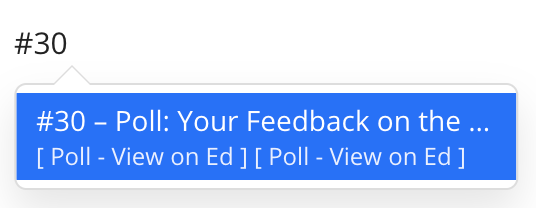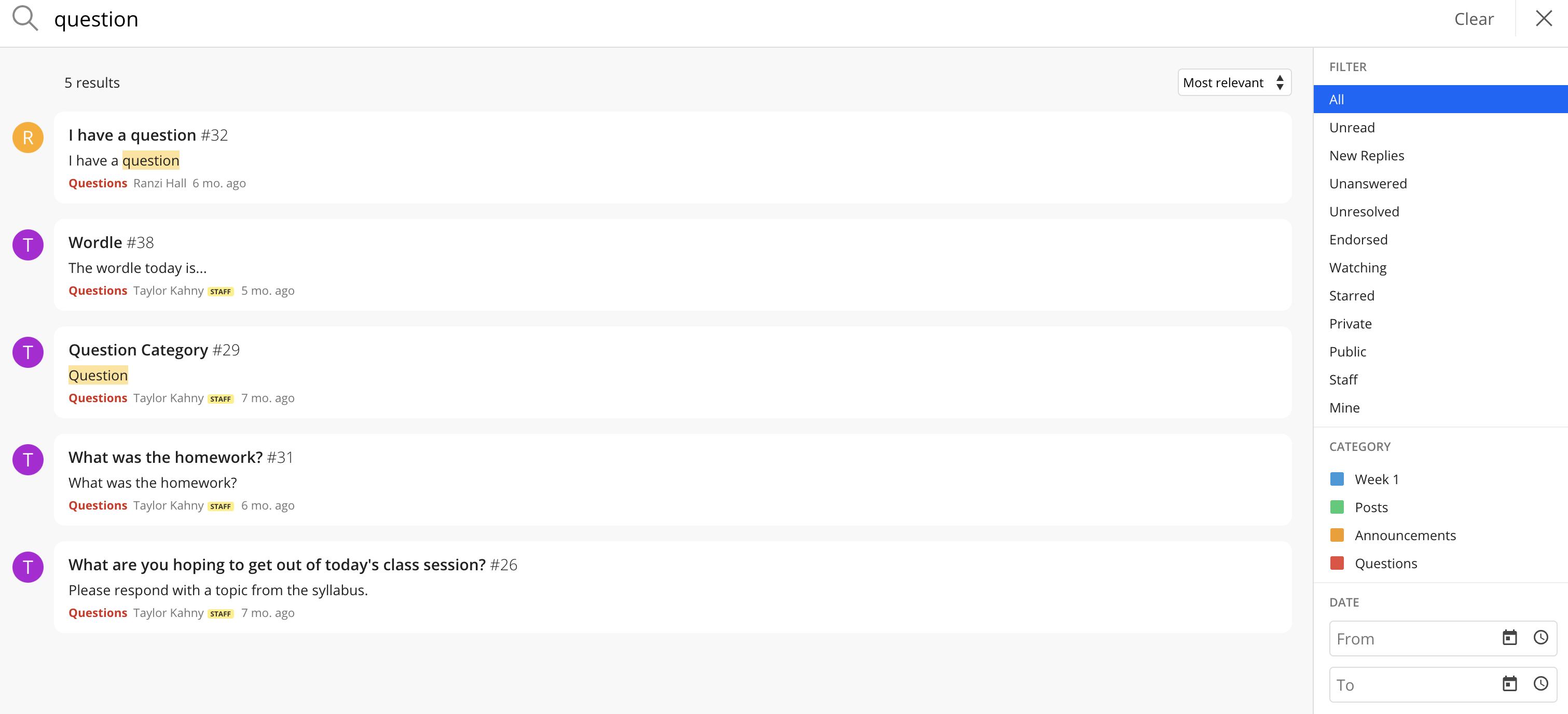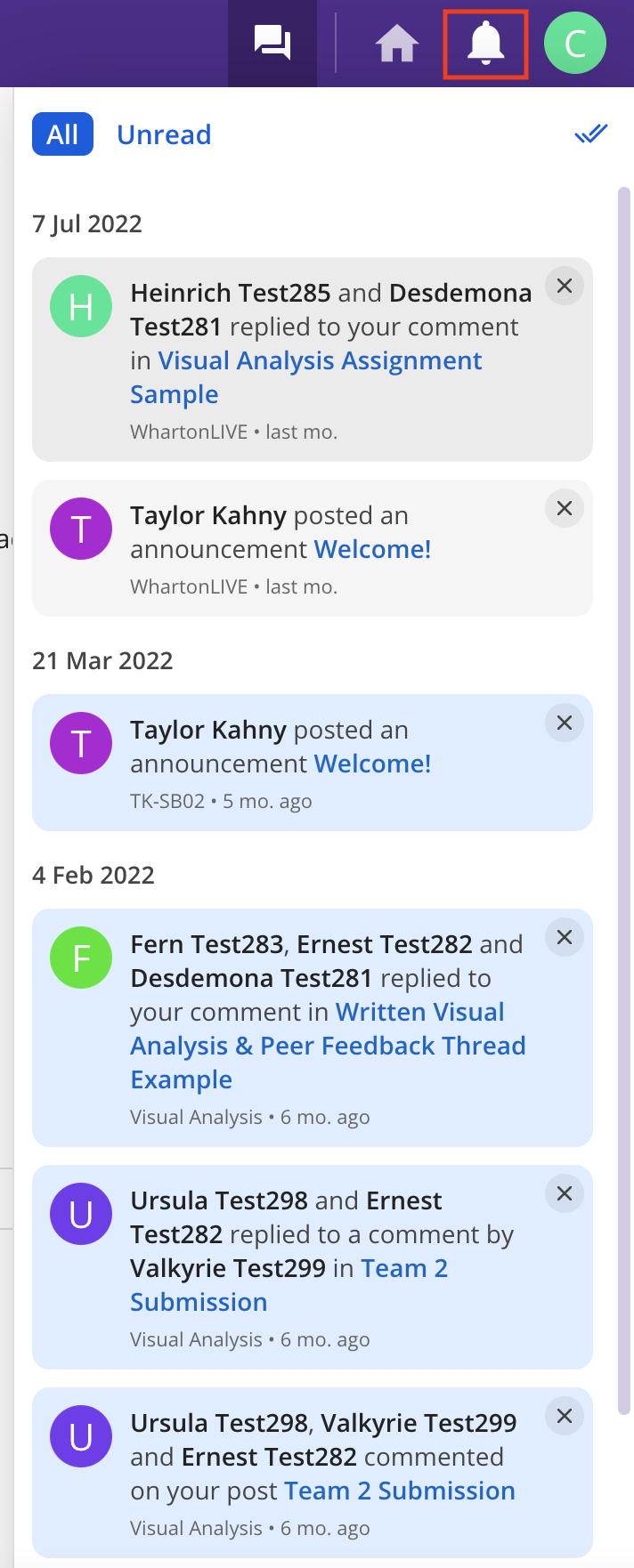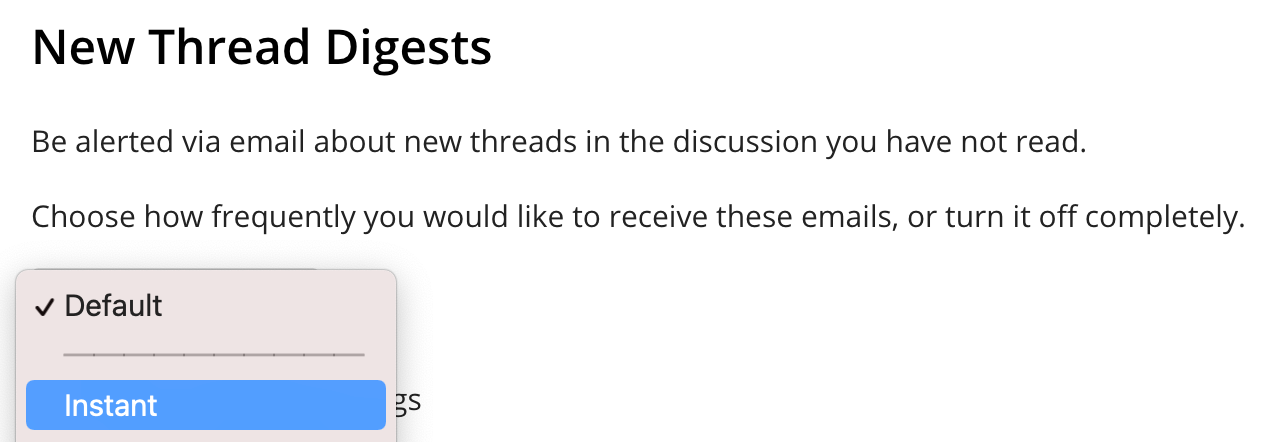As of May 2022, Ed Discussion is available to all Penn faculty, staff, and students. A Canvas integration is available for all courses taught through Penn Canvas.
Ed Discussion is an asynchronous discussion tool that provides a platform for students and members of the teaching team to interact through threaded conversation. Students can answer one another’s questions, work on and run code together, embed videos, annotate images, and share documents. They can also like one another’s posts, post anonymously, and receive instructor feedback all in one place.
In this article, you will learn more about the student experience in Ed Discussion. For information on utilizing Ed Discussion in your course as an instructor, view the guide linked here.
Before You Start
You will need the following before you can complete this task:
- You will need access to Canvas.
- If you are using Ed Discussion in a course that does not use Canvas, you may log in with your Penn email address at edstem.org/us/login.
Navigating Ed
From the student perspective, Ed Discussion has a clear set of color-coded categories, a searchable discussion area, and a big blue button for posting new threads. As with any tool, it is important to consult your professor or other teaching team members to best understand how this will be used in class. Some faculty include a pinned thread containing these instructions, so you can check for this, as well. The categories you see on the lefthand side are customizable and will differ from course to course, so keep this in mind when learning the functionality:

Edward Tao, Penn Engineering, via https://online.seas.upenn.edu/student-knowledge-base/ed-discussion/
Creating a New Thread
When creating a new thread as a student, you will see the option to pose a question or post. Note that the grayed-out item indicates it is deselected, while the colored item (shown below in pink) indicates a selection. In this example, the student has selected to pose a question:

Anything you post will need to include a title, category, and sub-category, if applicable. Once you begin typing your title, you can also see a drop-down for similar threads if you would like to reference an earlier post. To link to an earlier thread within the new post, since all threads are numbered, you can type the hashtag (#) sign followed by the thread's unique numeric value:

In order to start drafting the question or post, you will need to first select a category. Once the selection is made, you will see the tool's rich content editor. The question or post can be private to just you and the teaching team, or you can share with the class while making it anonymous to other students:

In the example below, an anonymous user posted a question about the homework under the Problem Sets category. In response, Ishtar answered the question by posting a guide which Cady found to be "very helpful." Also visible in the screenshot, students have the ability to "heart" questions, answers, posts, and comments they love, and they can also "star" and "watch" questions or posts, making it easier to filter the content in the discussion area:

Rich Content Editor
When you draft a new thread or comment on someone else's content, you will edit the post through the rich content editor. The editor provides tools for formatting text, inserting media, LaTex, and other programming language snippets. In addition, you can directly create formatted text and mathematical equations by typing in Markdown and LaTex syntax:

Ed - Quick Start Guide (Version One), via https://edstem.org/quickstart/ed-discussion.pdf
Categories
When toggling among categories within Ed Discussion, the chosen category's threads will appear underneath the search bar within the discussion area as shown below:

Each thread in the category is organized by date with the category, author, and related icons indicated on each separate post. Your instructors may have as many or as little categories as they choose.
Important Key for Understanding Thread Icons
- Threads with a blue dot
 are unread. These are threads that you have not seen.
are unread. These are threads that you have not seen. - Threads with a green tick
 are questions that have been resolved. This means that the question has already been answered.
are questions that have been resolved. This means that the question has already been answered. - Threads with a purple pin
 have been pinned and will be kept at the top of the discussion list to increase visibility and encourage ongoing discussions. Pinned threads are generally reserved for announcements or important information. Only instructors can choose which threads to pin.
have been pinned and will be kept at the top of the discussion list to increase visibility and encourage ongoing discussions. Pinned threads are generally reserved for announcements or important information. Only instructors can choose which threads to pin. - Threads with a blue ribbon
 have been endorsed by course instructors. This is usually done by instructors to distinguish high-quality content.
have been endorsed by course instructors. This is usually done by instructors to distinguish high-quality content. - Threads with a heart signify agreement.
 Hearts are private and do not reveal identities.
Hearts are private and do not reveal identities. - Threads with a star are bookmarked
 to refer back to later. Stars are private to the individual.
to refer back to later. Stars are private to the individual. - Threads with an eye icon selected
 are those in which you are subscribed to receive thread activity email notifications.
are those in which you are subscribed to receive thread activity email notifications. - Threads with the "S" icon
 indicate a student has answered a question thread.
indicate a student has answered a question thread. - Threads with the "I" icon
 indicate an instructor has answered a question thread.
indicate an instructor has answered a question thread.
Filtering
In terms of organizing your view as a student, Ed Discussion allows for many filtering options. You can filter by unread items; the latest replies; threads that are unanswered (for questions only), unresolved (for questions only), or endorsed; items you have set to watch or have starred; your private content; any public content; posts from the teaching team; and threads only created by you:

Searching
In order to quickly find posts within the discussion area, you can use the search bar to extract key words from threads. In the example below, the word "question" appears in five different posts within this particular course's Ed Discussion site:

To drill down the search even further, you can select one of the filtered options, a specific category, or even a date range.
Notifications
In the upper right corner of your screen, next to the home dashboard, you will see a bell icon indicating notifications. The notifications are organized by date with a section for "All" notifications and "Unread" notifications. There is also an icon enabling you to mark all notifications as "Read." Similar to the color scheme when posting a new thread, any item that is unread appears blue, while the notifications you have already read are grayed out as shown below:

Please note that you will not receive Ed Discussion notifications via Canvas directly, as this is an LTI tool existing as a separate application.
To customize your notification settings, see the Profile Settings section below.
Profile Settings
In Ed Discussion, there are ways to further customize your user experience in the Settings tab under your account profile:

From the Account section pictured above, check to make sure your primary email address is set to your Penn email address. This way, you will receive all Ed Discussion notification emails at this address.
For added security measures, you can also set a password or enable Two-Factor Authentication for your account.
To edit your notification settings, you can toggle to the Notifications tab shown below:

You can enable desktop notifications, choose how frequently you receive emails from Ed Discussion or turn this off entirely, and you can toggle various options for the email notifications you would like to receive.
To receive automatic emails from Ed Discussion directly to your @upenn email address, the notifications should be changed to "Instant" rather than the default option:
Under the Appearance tab, Ed Discussion enables you to change from Light to Dark mode, even providing an option to sync the particular mode with your operating system's settings. In addition, you can change the threaded list style to full (default), compact, or ultra compact.

The Language & Region and My Courses tabs enable you to alter the language and time zone and view all courses you are enrolled in that utilize Ed Discussion. Under My Discussions, you can drill down to specific threads, answers, and comments you have made on your course discussion boards, making it easy to return to a conversation without having to search through all user threads:

Using Ed on a Mobile Device
For those who wish to post discussions and respond on a mobile device, it is recommended to add Ed to the phone's homescreen for easy access:
For iOS, visit edstem.org in Safari and tap Share>Add to Home Screen.
For Android, visit edstem.org in Chrome, tap the menu icon (3 dots in upper right corner), and select Add to Home Screen.
Questions?
If you need more assistance, please contact courseware@wharton.upenn.edu for support.

 Hearts are private and do not reveal identities.
Hearts are private and do not reveal identities.  to refer back to later. Stars are private to the individual.
to refer back to later. Stars are private to the individual.  are those in which you are subscribed to receive thread activity email notifications.
are those in which you are subscribed to receive thread activity email notifications. indicate a student has answered a question thread.
indicate a student has answered a question thread. indicate an instructor has answered a question thread.
indicate an instructor has answered a question thread.